-
PDF
- Split View
-
Views
-
Cite
Cite
Laura Marian, Robert E. Smith, Raul E. Angulo, An exploration of galaxy–galaxy lensing and galaxy clustering in the Millennium-XXL simulation, Monthly Notices of the Royal Astronomical Society, Volume 451, Issue 2, 01 August 2015, Pages 1418–1444, https://doi.org/10.1093/mnras/stv984
Close - Share Icon Share
Abstract
The combination of galaxy–galaxy lensing and galaxy clustering data has the potential to simultaneously constrain both the cosmological and galaxy formation models. In this paper, we perform a comprehensive exploration of these signals and their covariances through a combination of analytic and numerical approaches. First, we derive analytic expressions for the projected galaxy correlation function and stacked tangential shear profile and their respective covariances, which include Gaussian and discreteness noise terms. Secondly, we measure these quantities from mock galaxy catalogues obtained from the Millennium-XXL simulation and semi-analytic models of galaxy formation. We find that on large scales (R > 10 h−1 Mpc), the galaxy bias is roughly linear and deterministic. On smaller scales (R ≲ 5 h−1 Mpc), the bias is a complicated function of scale and luminosity, determined by the different spatial distribution and abundance of satellite galaxies present when different magnitude cuts are applied, as well as by the mass dependence of the host haloes on magnitude. Our theoretical model for the covariances provides a reasonably good description of the measured ones on small and large scales. However, on intermediate scales (1 < R < 10 h−1 Mpc), the predicted errors are ∼2–3 times smaller, suggesting that the inclusion of higher order, non-Gaussian terms in the covariance will be required for further improvements. Importantly, both our theoretical and numerical methods show that the galaxy–galaxy lensing and clustering signals have a non-zero cross-covariance matrix with significant bin-to-bin correlations. Future surveys aiming to combine these probes must take this into account in order to obtain unbiased and realistic constraints.
1 INTRODUCTION
Since the first pioneering attempt to measure the galaxy–galaxy lensing (hereafter GGL) signal by Tyson et al. (1984), there have been significant technological developments in deep and wide-field astronomy, which have led to the emergence of GGL as one of the most promising probes for simultaneously constraining both the cosmological and galaxy formation models.
The first robust detection of the GGL signal was made by Brainerd, Blandford & Smail (1996) using 90 arcmin2 of imaging data from the 5 m Palomar telescope. They showed that whilst the tangential shear profile around individual galaxies was too weak to be measured, the stacked signal around all lens galaxies could be detected with high signal-to-noise. Since then there has been a rapid explosion in the field: the addition of the Wide-Field Camera to the Hubble Space Telescope enabled a number of key GGL studies (dell'Antonio & Tyson 1996; Griffiths et al. 1996; Hudson et al. 1998; Leauthaud et al. 2012). The improvement of ground-based facilities such as the Canada–France–Hawaii Telescope has also led to significant developments (Wilson et al. 2001; Hoekstra, Yee & Gladders 2004; Parker et al. 2007; van Uitert et al. 2011; Hudson et al. 2015; Velander et al. 2014). However, perhaps the most prolific work in this area comes from the analysis of the data from the Sloan Digital Sky Survey (hereafter SDSS; Guzik & Seljak 2001, 2002; McKay et al. 2001; Hirata et al. 2004; Sheldon et al. 2004, 2009a,b; Mandelbaum et al. 2005, 2006a,b,c, 2013; Johnston et al. 2007; Nakajima et al. 2012). All these works have revealed that the GGL signal is a complex function depending on a number of galaxy properties, such as luminosity, colour, spectral type, etc. The key importance of GGL is that it enables one to make a direct link from galaxy properties to the underlying dark matter distribution. Indeed, these works have also constrained the mass, density profiles, ellipticity of the dark matter haloes hosting the lens galaxies.
One of the first to realize that cosmic shear could help to simultaneously constrain galaxy formation and cosmology, through directly measuring the bias, was Schneider (1998). Schneider's approach of using aperture mass filters was implemented by Hoekstra et al. (2002) who directly measured galaxy bias, establishing that it was a complicated function of scale. This approach was further theoretically developed for the halo occupation distribution framework by Guzik & Seljak (2001) and later by Seljak et al. (2005) and Yoo et al. (2006). More recent work has been performed by Cacciato et al. (2009, 2013) who have combined the results from GGL and galaxy clustering (hereafter GC) studies, along with measurements of the galaxy luminosity function (hereafter GLF) from SDSS to constrain the parameters of the conditional luminosity function (hereafter CLF) model – which fully specifies the link between a given dark matter halo and the galaxies it hosts, albeit with assumptions about the functional form of the CLF (Yang, Mo & van den Bosch 2003; van den Bosch et al. 2013). An interesting result to emerge from this work was that if one did not include the GGL measurements in the analysis, then equally good fits to the CLF model parameters could be obtained for either Wilkinson Microwave Anisotropy Probe 1 (WMAP1) or WMAP3 cosmology (Spergel et al. 2003, 2007). Including the GGL data broke this degeneracy and identified the WMAP3 parameters as the preferred cosmological model. See also the very recent works of Miyatake et al. (2013) and More et al. (2014).
Whilst there has been significant progress in attempting to understand and interpret the GGL signal (see also Baldauf et al. 2010; Saghiha et al. 2012), our understanding of how to perform a robust likelihood analysis with such data sets has been lacking. For example, in the recent development of the CLF framework (Cacciato et al. 2013; More et al. 2013; van den Bosch et al. 2013), the GGL and GLF measurements were taken to have diagonal covariance matrices, and the GC covariance matrix was obtained from jackknife estimation. Moreover, these probes were assumed to have zero cross-covariance. This is clearly a simplification that future large data set analyses should improve on. A better analysis of the errors was performed by Leauthaud et al. (2012) who used numerical simulations to estimate the covariance matrices of the GGL and GC measurements, while Mandelbaum et al. (2013) used the jackknife approach. The very recent works of Miyatake et al. (2013) and More et al. (2014) also had an improved error analysis. However, again in their analyses the cross-covariance of the two measurements was assumed to be negligible.
If upcoming surveys such as Dark Energy Survey (DES), The Javalambre-Physics of the Accelerated Universe Astrophysical Survey (J-PAS), Euclid and Large Synoptic Survey Telescope (LSST) are to optimally constrain the cosmological model, then it is inevitable that they must also jointly constrain the model of galaxy formation. The best way to do this will be to combine the GGL, GC and GLF measurements. This will require not only accurate models for the signals themselves, but also accurate modelling of the covariance and cross-covariance matrices of these probes.
In this paper, we develop an analytical framework to compute both the covariance and cross-covariance of GC and GGL. Our work builds upon the analysis of the earlier work of Jeong, Komatsu & Jain (2009) for GGL and that of Smith & Marian (2014, 2015) for the GC signal. We then use the semi-analytic galaxy catalogues and dark matter distribution from the Millennium-XXL (hereafter MXXL) simulation (Angulo et al. 2012) to directly measure these observables and their associated auto- and cross-covariances, for several bins in luminosity. Unlike the CLF approach, semi-analytic models (hereafter SAM) make no direct assumption on how galaxies populate dark matter haloes. Instead, they attempt to model the relevant physical processes for galaxy formation and evolution, and how these are affected by environment and assembly history. Thus, the non-linearity and stochasticity of galaxy bias are predictions, not assumptions in our study.
The paper is structured as follows. In Section 2, we present the necessary theoretical expressions for modelling the stacked tangential shear profiles and projected GC signals. In Section 3, we present expressions for their associated auto- and cross-covariances. In Section 4, we provide an overview of the MXXL simulation and the SAM galaxy catalogues that we use. In Section 5, we present the measurements of the GGL and GC signals for a set of luminosity bins, and compare them with the predictions from the theory. In Section 6, we present our results for the GC and GGL covariance and cross-covariance matrices. In Section 7, we summarize our findings and draw our conclusions.
2 THEORETICAL PREDICTIONS FOR THE GGL AND GC SIGNALS
In this section, we present theoretical expressions for the stacked tangential shear signal of a population of galaxy lenses and the signal for the projected galaxy correlation function.
2.1 Overview of required lensing ingredients
2.2 Estimator for the stacked tangential shear
2.3 The projected galaxy correlation function
3 SIGNAL COVARIANCE MATRICES
In this section, we compute the auto- and cross-covariance matrices of the stacked tangential shear signal and the projected galaxy correlation function.
3.1 The covariance matrix of the stacked tangential shear estimator
The definition of the covariance of the estimator in equation (12) is
3.2 The covariance matrix of the projected galaxy correlation function estimator
3.3 The cross-covariance of the stacked tangential shear and the projected galaxy correlation function estimators
4 THE MXXL SIMULATION
The MXXL is the largest simulation in the Millennium series, with a volume of V = [3 h−1 Gpc]3 and 67203 dark matter particles of mass mp = 6.9 × 109 h−1 M⊙. The cosmological model corresponds to a flat Λ cold dark matter universe with the matter density parameter Ωm = 0.25, the dimensionless Hubble parameter h = 0.73, the amplitude of matter fluctuations σ8 = 0.9, the primordial spectral index ns = 1 and a constant dark energy equation of state with w = −1. For a complete description of the MXXL, we refer the reader to Angulo et al. (2012).
Halo and subhalo catalogues were stored for 63 snapshots. The smallest object in these catalogues has a mass ∼1.4 × 1011 h−1 M⊙. Merger trees were built by identifying for every subhalo in each snapshot the most likely descendant in the next snapshot. The trees were then used to build a galaxy catalogue with the SAM galaxy formation code l-galaxies (Springel et al. 2005).
The l-galaxies code corresponds to a set of differential equations that couple with the above-mentioned merger trees and that encode the key physical mechanisms for galaxy formation. Processes such as gas cooling, star formation, feedback from SN and AGN, galaxy mergers, black hole formation and growth, and generation of metals are all implemented in a self-consistent manner. We refer the interested reader to Guo et al. (2011), Henriques et al. (2012) and references therein for specific details on the method, and to Angulo et al. (2014) for details on the implementation in the MXXL simulation. Here, we just highlight that the galaxy population of a given halo does not depend on its mass alone, as commonly assumed in many models, but also on the details of the halo assembly history and environment. For each galaxy, the full star formation history is stored, and when coupled with population synthesis models and an assumed initial stellar mass function, it allows us to compute the expected luminosity for each of the five SDSS filters.
In Fig. 1, we present the luminosity function for the five SDSS bands. We find that all of the luminosity functions show qualitatively similar behaviour: a steep fall-off at bright magnitudes and a turn-over followed by a power-law-like tail at intermediate and faint magnitudes. We also see that for a given magnitude band, there are greater abundances of galaxies at red wavelengths than at blue. This is qualitatively consistent with observational results from the SDSS (Blanton et al. 2003). For the faintest magnitudes, we notice artefacts produced by the finite mass resolution of the MXXL simulation. We elaborate on this next.
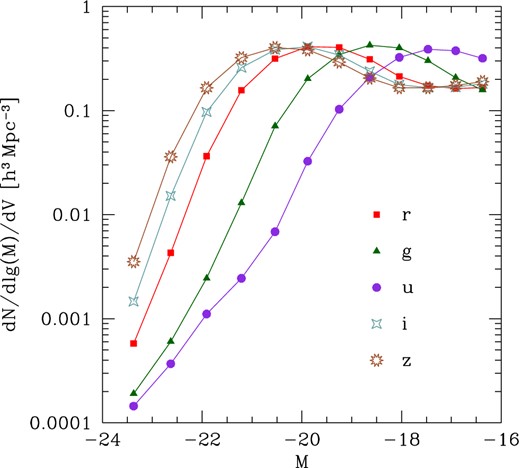
Luminosity function of semi-analytic galaxies in the MXXL simulation, in the five SDSS bands r, g, u, i, z. Note that artefacts produced by the finite mass resolution of the simulation are evident for M ≥ −20 to −19.
In the upper-left panel of Fig. 2, we present the relative abundance of central, satellite and orphan galaxies as a function of their red-band absolute magnitude. ‘Central’ galaxies reside at the centres of the main halo (subhalo), and are therefore the main galaxies of the friends-of-friends (FoF) haloes. ‘Satellite’ galaxies inhabit satellite subhaloes within the FoF haloes. ‘Orphan’ galaxies are satellite galaxies whose dark matter subhalo has been stripped down below the resolution limit of the simulation. The figure clearly shows that the brightest galaxies (Mr ≤ −18) are mostly centrals. The satellites with a resolved dark matter subhalo are sub-dominant for all magnitude bins, but dominate among satellite galaxies with Mr < −20. These features depend on the mass resolution of the simulation (see Fig. B1 for an analogous figure constructed from the higher resolution Millennium simulation). With a much higher mass resolution, central galaxies would dominate at any luminosity and there would be no orphan galaxies.
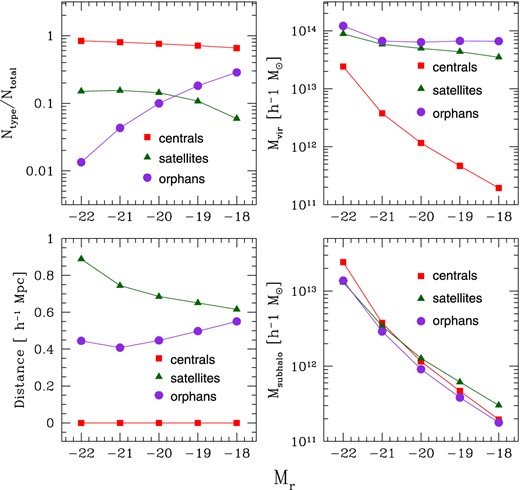
Galaxy properties as a function of absolute red-band magnitude. The galaxies are at redshift 0.24. Upper-left panel: the ratio of the number of galaxies of each type to the total number of galaxies in the respective magnitude bin. Upper-right panel: the virial mass of the host halo. Lower-left panel: the average distance of galaxies to the central galaxy. Lower-right panel: the mass of the subhaloes where the galaxies formed.
The upper-right panel of Fig. 2 shows how the mass of the host haloes evolves with the galaxy luminosity. Independent of the brightness of satellite and orphan galaxies, the haloes hosting them are quite massive (Mvir ∈ [3 × 1013, 1014] h−1 M⊙), whereas the haloes inhabited by central galaxies display a substantial decrease in mass with decreasing luminosity. This drop in halo mass spans more than two orders of magnitude, starting at M ∼ 2 × 1013 h−1 M⊙.
The bottom-left panel of Fig. 2 shows the average distance of the galaxies from the central galaxy, as a function of magnitude. By definition, the distance of central galaxies is zero. Satellite galaxies are on average most distant from the halo centre: the brightest have a separation of ∼0.9 h−1 Mpc, and the faintest of about 0.6 h−1 Mpc. On the other hand, orphan galaxies are on average within [0.4, 0.6] h−1 Mpc from the halo centre, which is a consequence of tidal forces being stronger closer to the halo centre where tidal disruption and mass-loss happen.
Finally, the bottom-right panel of Fig. 2 presents the evolution of the host subhalo mass with luminosity. For centrals, this is in fact the same as shown in the upper-right panel; the other two types follow the same trend as the centrals. Note that the subhalo mass associated with the orphan galaxies is defined to be the mass of the last subhalo tracked before it fell below the mass resolution of the simulation. We can see that there are no strong differences among different types which is a consequence of the fact that the r-band magnitude mostly traces the total amount of mass in stars, which in turn depends primarily on the total amount of gas available for star formation and thus on the mass of the host dark matter structure.
In this paper, we shall use only the red band, since most of the GGL and GC studies to date have focused on this band. We shall only consider galaxies with Mr < −19, split into four absolute-magnitude bins, with each bin spanning a single unit of magnitude, except for the brightest bin for which we take all galaxies with Mr < −22. We have ensured that above the chosen limit Mr < −19, our results are qualitatively insensitive to the finite mass resolution of the MXXL by explicitly comparing the GGL and GC signals with those derived from the higher-resolution Millennium simulation.
5 RESULTS I: CLUSTERING AND LENSING MEASUREMENTS IN MXXL
5.1 Methodology for estimating the projected correlation functions
In order to estimate the GGL and GC signals and their covariance from the MXXL data, we divide the simulation box into 216 subcubes of volume Vsub = [500 h−1 Mpc]3. Each subcube therefore contains ≈1.4 × 109 dark matter particles, as well as galaxies from the catalogues described in Section 4. For our analysis, we assume both the Born and Limber approximations, which allow us to perform all of the computations at the fixed redshift z = 0.24. For each of the subcubes, we measure the projected matter–matter, galaxy–matter and galaxy–galaxy correlation functions. In order to handle the huge data volume, we have developed a fast k-D tree code in c++ with MPI parallelization. Our algorithm is similar to that described by Moore et al. (2001) and Jarvis, Bernstein & Jain (2004). However, rather than invoking an approximate scheme for binning the pair counts as is done in these algorithms, we place every particle exactly into the correct radial bin. We have carefully tested that our code obeys the pair counting scaling DD ∝ t3/2 and that it reproduces exactly the answer obtained from a brute-force pair summation code.
We found that it was crucial to correct the projected correlation functions for the integral constraint, otherwise the results exhibited a strong dependence on the projection length χmax. This owes to the fact that the total density of objects in each subcube is not guaranteed to reach the universal mean.
Finally, we mention the choice of bins: we have 25 logarithmic bins in R, spanning the interval [0.04, 54] h−1 Mpc, and 10 linear bins in χ, with a chosen χmax of 100 h−1 Mpc. We checked that the number of line-of-sight bins is sufficiently large to obtain an accurate estimation of the projected correlation function.
To summarize: the projected correlation functions are estimated through the following steps: (i) use the tree code to evaluate the 3D pair counts for each (R, χ) bin, and for every subsample; (ii) build the Landy–Szalay estimator for the 3D correlation function from the pair counts and determine the integral constraint factor; (iii) add the line-of-sight bins to obtain the projected correlation functions, i.e. compute |$\widehat{w}_{\rm corr}$| following equation (38); (iv) calculate the average of the subsamples.
5.2 Galaxy and matter correlation functions
Fig. 3 presents the projected matter–matter, galaxy–matter and galaxy–galaxy correlation functions – red, green and blue solid lines, respectively – from the 216 subcubes of the MXXL. Each line corresponds to the estimate from one subcube, and each panel to a magnitude bin, starting with the brightest galaxies in the upper-left corner, and down to the faintest in the lower-right corner. The measurements have some scatter for the two brightest magnitude bins, but are relatively tight otherwise. This plot also provides a check that none of the subcubes displays any anomalous behaviour.
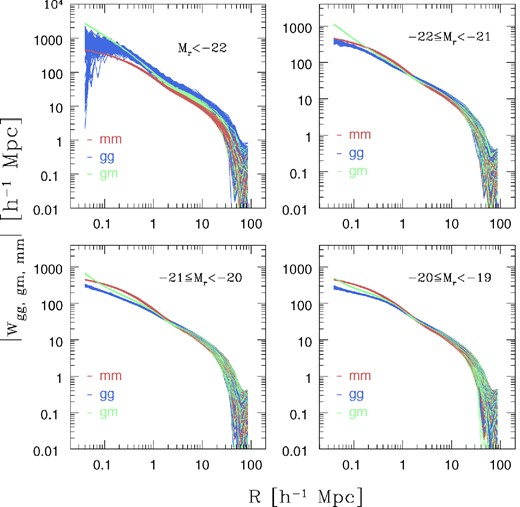
Projected correlation functions measured for all 216 subcubes of the MXXL at redshift 0.24. The red, blue and green lines represent the matter–matter, galaxy–galaxy and galaxy–matter correlation functions, respectively. In each panel, the galaxies are binned according to their r-band absolute magnitudes.
5.3 Galaxy bias and cross-correlation coefficient
Fig. 4 presents the two bias estimates for all magnitude bins and averaged over all 216 subcubes of the MXXL simulation. There are several points worth noticing in these figures. First, on large scales, we see that both bgg and bgm appear to be constant and qualitatively consistent with one another. We also note that the bias is relatively similar for the fainter bins, but it increases sharply for the brightest galaxies. This luminosity dependence of the bias in SAM models is consistent with earlier studies (see Smith 2012, and references therein), and can be understood from Fig. 2. There we see that it is only for the brightest magnitude bin that the host haloes of both the central and satellite galaxies are very massive. For the fainter bins, the mass of the host haloes decreases with luminosity in the case of central galaxies, while remaining relatively constant in the case of the satellites. Thus, the bias of the latter is boosted. This explanation is consistent with the picture where an individual galaxy inherits the bias of the halo hosting it.
On smaller scales, we notice that bgm > bgg: the scale where this transition occurs decreases with increasing absolute magnitude, ranging from R ∼ 1 h−1 Mpc for the brightest galaxies to R ∼ 0.07 h−1 Mpc for the faintest bin. The fact that bgm > bgg can be qualitatively understood from the following reasons. The 3D galaxy–galaxy correlations in SAM models obey an exclusion condition, which is that individual galaxies cannot come closer than the separation of the sum of their individual subhalo virial radii. On scales smaller than this, the correlation function drops to −1. Whereas for the galaxy–matter cross-correlation function, no such exclusion is present and one simply probes the density profile of matter around galaxies – which is known to be cuspy (Hayashi & White 2008). However, in projection these effects are less significant, but nevertheless still operate and lead to the shape shown in Fig. 4. The transition scale varies with magnitude because the halo mass of central galaxies decreases with increasing absolute magnitude (cf. Fig. 2).
Fig. 5 shows the cross-correlation coefficient as a function of the transverse scale R. We find that on large scales, the correlation coefficient approaches unity for the four magnitude bins that we have considered. This implies that, at least for the SAM galaxies in MXXL, the large-scale bias is linear and deterministic and that it describes both the galaxy–galaxy and galaxy–matter correlation functions. On small scales, we see that the correlation coefficient decreases sharply and then shoots up above unity. This is consistent with the non-linear scale-dependent bias presented in Fig. 4. Note that the small-scale clustering of galaxies is very sensitive to the treatment of dynamical friction of orphan galaxies, so we do not wish to overinterpret the results of Figs 4 and 5 for R < 100 h−1 kpc.
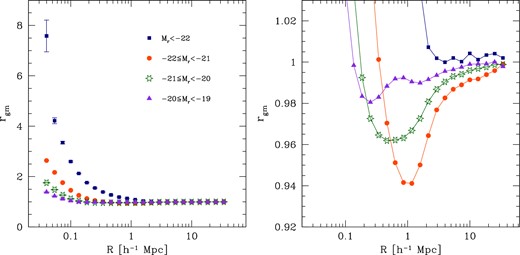
The average cross-correlation coefficient, e.g. equation (41) as a function of transverse radius. Left-hand panel: the full range.Right-hand panel: zoom-in.
5.4 Comparison of the measured and theoretical projected galaxy correlation function
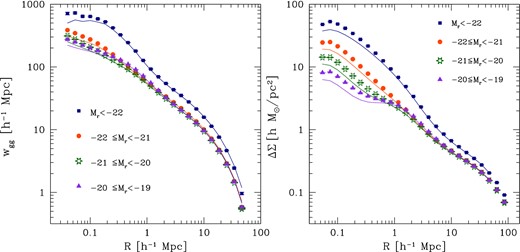
Left-hand panel: the projected galaxy correlation function for various magnitude bins. The symbols denote the average of the 216 subcubes; the error bars are on the mean. The lines represent the theoretical predictions of equation (26). Right-hand panel: the excess surface density. Symbols and lines are just like in the left-hand panel.
In Fig. 6 we see that on small scales R < 0.1 h−1 Mpc, the predictions underestimate the measured wgg by roughly ∼20 per cent. These discrepancies are attributed to the fact that halofit underpredicts the true non-linear matter power spectrum on small scales (Takahashi et al. 2012). The more recent work of Fosalba et al. (2015a,b) shows however that the revised halofit of Takahashi et al. (2012) overpredicts the non-linear power spectrum and consequently also the convergence power spectrum on small scales. Since the agreement between halofit models and simulation measurements depends on both the mass resolution and the volume of the simulations – the closer the simulations’ specifications to those used for the calibration of the semi-analytical prescriptions, the better the agreement – we defer more sophisticated theory predictions to a future work and are satisfied for now that the original halofit of Smith et al. (2003) gives reasonable enough answers for our purpose here.
It is also interesting to note that the faintest galaxies yield high projected correlation functions around 1 h−1 Mpc, most likely due to contributions from the satellite galaxies, which inhabit higher mass haloes and are therefore more biased.
5.5 The stacked tangential shear of galaxies
The right-hand panel of Fig. 6 presents a comparison between the theoretical predictions and measurements of ΔΣ as a function of the transverse spatial scale R, for the four magnitude bins considered. The symbols correspond to the simulations and the lines to the theory predictions. On large scales, R > 10 h−1 Mpc, we see that similar to wgg, the shear amplitudes in the three faintest bins are comparable, whereas the brightest galaxies have a higher amplitude. On smaller scales, R < 0.5 h−1 Mpc, we find a systematic trend: the brighter the galaxies, the larger the amplitude of the tangential shear profile. This finding is in accord with the GGL measurements from the SDSS by Mandelbaum et al. (2006a).
On closer inspection of the faintest luminosity bin, we see that it appears to have a somewhat broad, flattish shear profile, with a very slight second peak at ∼1 h−1 Mpc, and higher amplitude than the brighter bins (excepting the brightest bin) on intermediate scales 2 < R < 10 [ h−1 Mpc]. This might be due to the increased relative abundance of satellite galaxies compared to centrals. The satellite galaxies are mainly hosted by high-mass haloes and have an average distance from the centre of the main halo that is roughly of the order of ∼0.5 h−1 Mpc, and so we expect that their tangential shear profiles receive two significant contributions: the first from the dark matter associated with their own subhalo; the second comes as the shear profile radius encompasses the central cusp of the main halo. This qualitatively explains the broadening of the profile of the faintest bin. We also note that the theory underpredicts the measurements more significantly than for wgg. This can be attributed to the small-scale inaccuracies of halofit contributing to |$\overline{w}_{\rm gm}(<\!\!R)$| at all radii.
6 RESULTS II: COVARIANCE MATRICES FROM THE MXXL
6.1 Covariance of the projected correlation function
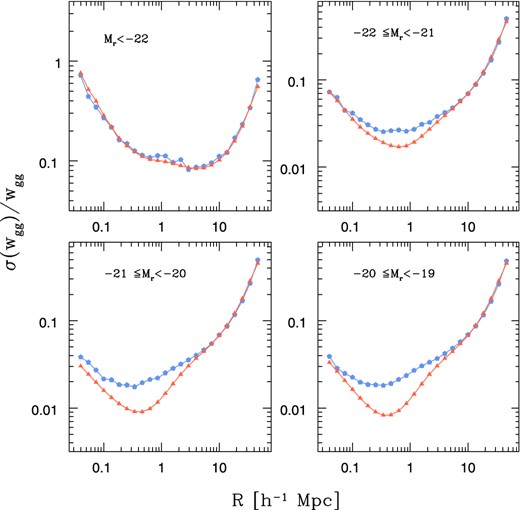
The noise-to-signal for the projected galaxy correlation function. The red triangles represent the theory prediction, and the blue pentagons the simulation measurements.
The theoretical predictions for the brightest galaxies agree extremely well with the measured errors. This owes to the fact that on large scales, R > 10 h−1 Mpc, the errors are determined by the Gaussian part of the variance. On smaller scales, these objects are relatively sparse, and so the shot-noise contribution to the variance quickly dominates. Both of these two limits are well characterized by our formula.
For the fainter magnitude bins, there is reasonably good agreement between our model and the data on both large (R > 10 h−1 Mpc) and small (R < 0.1 h−1 Mpc) scales. The former is due to the prominence of Gaussian contributions on large scales, whereas the latter is due to the shot-noise dominance on small scales. However, on intermediate scales (0.1 < R < 1 h−1 Mpc), the agreement is not so good, and we see that the data have errors roughly a factor of ∼2 larger than the predictions. This is to be expected, since for these scales the non-Gaussian corrections (e.g. the connected part of the trispectrum and also the bispectrum), which we neglected in deriving equation (32), are significant and have the effect of increasing the errors.
Fig. 8 shows four rows of the correlation matrix of |$ {r}[\widehat{\overline{w}}_{\rm gg}]$| at radii (Ri, Rj) as a function of Rj and at fixed radius Ri. The fixed scales correspond roughly to Ri = 0.04, 0.1, 1, 10 h−1 Mpc, and in each panel can be quickly determined by noting that |$r[\widehat{\overline{w}}_{\rm gg}](R_i=R_j)=1$|. From left to right, each column represents a magnitude bin.
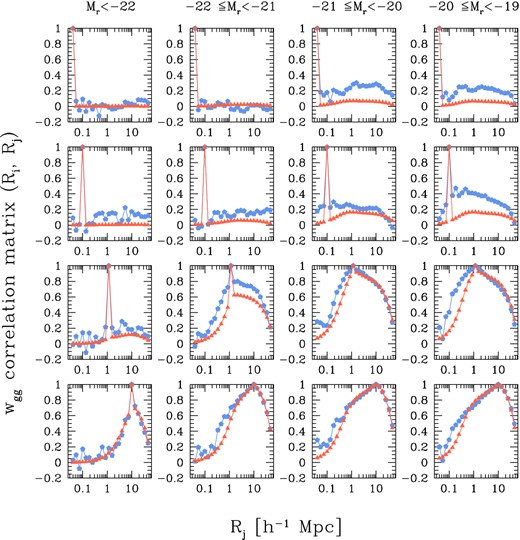
The correlation matrix from equation (50) for the projected galaxy correlation function. From top to bottom, the rows present four scales: Ri = 0.04, 0.1, 1, 10 h−1 Mpc. From left to right, the columns depict the four magnitude bins, as indicated in each panel. The symbols are the same as in the previous figure.
There are some notable trends: when the fixed scale Ri is large (bottom row of the figure), the neighbouring bins of the matrix are significantly correlated, and the strength of the correlations is |$r[\widehat{\overline{w}}_{\rm gg}]>0.5$|. There is a decrease in the correlation coefficient as one considers brighter magnitude bins. These findings are in good agreement with our Gaussian model. When the fixed scale is small (Ri = 0.04 Mpc), for the brighter galaxy bins there is virtually no evidence for bin-to-bin correlations. Again this is consistent with the predictions of our model, and is attributed to the fact that for so few objects the shot-noise errors simply dominate. However, when we consider the intermediate scales (second and third rows of panels in the figure), the model predictions underestimate the bin-to-bin correlations that are exhibited by the data. We interpret this as a sign that the non-Gaussian contributions to the covariance matrix, which we have neglected in our model, are significant. For a more intuitive but less quantitative depiction of the GC correlation matrix, as well as the GGL one and their cross-correlation, we refer the reader to Figs 13–16.
6.2 Covariance of the stacked tangential shear
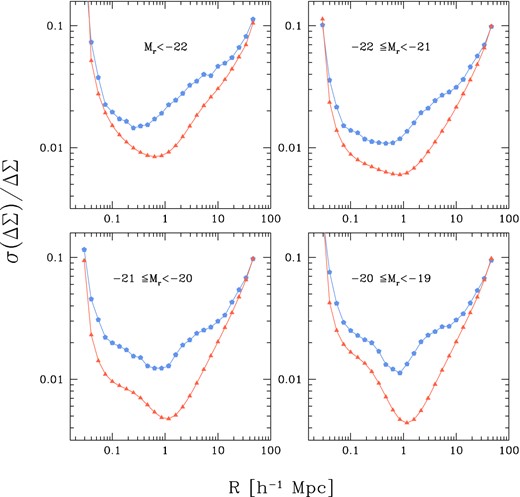
The noise-to-signal for the stacked tangential shear. The red triangles represent the theory predictions, while the blue pentagons correspond to the simulation measurements.
The theory predictions of equation (53) are presented as the red triangles in Fig. 9. As in the case of wgg, we see that the agreement between theory and measurements is good on large (R > 10 h−1 Mpc) and small (R < 0.1 h−1 Mpc) scales. However, on intermediate scales the theory underestimates the true errors. We also notice that the predictions are increasingly poor for the fainter galaxies. For the brightest galaxies, the discrepancy at R ∼ 1 h−1 Mpc is roughly a factor of ∼2, whereas for the faintest galaxies it is roughly ∼3. Thus, compared to wgg, the predictions for the stacked shear seem worse, even for the shot-noise-dominated brightest galaxies. This suggests that the non-Gaussian contributions to the variance are more important for the stacked tangential shear than for the projected correlation function. However, in a real shear survey, this discrepancy may not be so crucial, since the addition of the shape-noise term will certainly be a strong source of noise on small scales. In Appendix C, we present a theoretical estimation of the impact of shape noise on the GGL variance and correlation matrix.
Fig. 10 presents four rows of the correlation matrix of |$\widehat{\overline{\gamma }}^g_t$| at {Ri, Rj} as a function of Rj and for fixed Ri, with the covariance estimated according to equation (52). The measurements are represented in the figure as the blue pentagons. The theoretical predictions are obtained by evaluating equation (53), and are denoted by the red triangles. The general trends are similar to those found in Fig. 8: on small scales (Ri = 0.04 h−1 Mpc, i.e. the top row of the figure), the theory and measurements show weak bin-to-bin correlations and the measurements seem somewhat noisy. Qualitatively, they are consistent with uncorrelated noise. On large scales (Ri = 10.0 h−1 Mpc, i.e. the bottom row of the figure), the measurements show significant bin-to-bin correlations. However, the correlations appear to be somewhat weaker than was found for the projected correlation function for more distant bins. In addition, the Gaussian predictions of our model do not describe these correlations as well as in the case of wgg. On intermediate scales, 1 < Ri < 10[ h−1 Mpc], the correlations are significantly stronger for all magnitude bins than predicted by our theoretical model. Once again, this suggests that the tangential shear signal is significantly more non-Gaussian on these scales than the projected galaxy correlation function.
6.3 Cross-covariance of the projected correlation function and stacked tangential shear
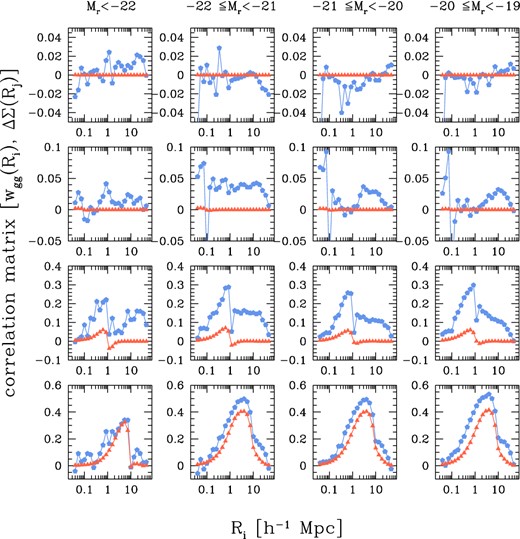
The cross-correlation matrix of the projected galaxy correlation function and the stacked tangential shear, this time fixing Rj = 0.04, 0.1, 1, 10 h−1 Mpc.
On small scales (R < 0.1 h−1 Mpc, i.e. the top row of the figures), we see that for all of the magnitude bins considered, the cross-correlation coefficient is small (r < 0.2), and reasonably consistent with the theoretical predictions from equation (58). On large scales (R ∼ 10 h−1 Mpc, i.e. the bottom row in the figures), the cross-correlation coefficient is larger, with r ∼ 0.8 for some of the bins. Also, the theoretical predictions are qualitatively in agreement, although the measurements do show a stronger degree of correlation. On intermediate scales (the middle two rows), the measurements show stronger bin-to-bin correlations than predicted by the theory. These correlations on intermediate to large scales are important to include in any joint likelihood analysis of GC and GGL. Otherwise, the likelihood search may lead to biased and overoptimistic parameter constraints.
6.4 Testing the jackknife method to estimate covariances
We now want to see how the correlation matrices estimated from the entire MXXL data compare to those evaluated through the jackknife method.
We pick one of the subcubes of the simulation, and generate 64 jackknife samples by removing a region of the subcube and estimating the projected correlation functions from the remaining data. The regions that are removed are in the shape of a rectangular parallelepiped, with the long side aligned with the |${\hat{\boldsymbol z}}$| direction of the subcube, i.e. the projection direction, and the shorter sides describing a square in the |${\hat{\boldsymbol x}}{\rm -}{\hat{\boldsymbol y}}$| plane. The latter is obtained by dividing the subcube side into eight equal segments along both |${\hat{\boldsymbol x}}$| and |${\hat{\boldsymbol y}}$| directions, resulting in 64 adjacent squares. Thus, the dimensions of each parallelepiped are 62.5 × 62.5 × 500 [ h−1 Mpc]3.
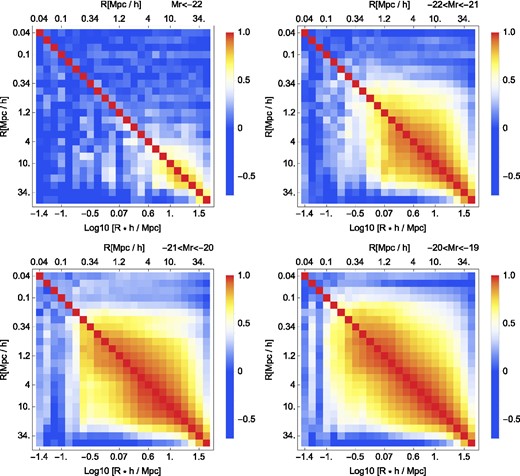
The correlation matrix of wgg for the four magnitude bins considered. The upper-right triangle of the matrix represents the correlation matrix measured from the whole simulation, i.e. the same as in Fig. 8. The lower-left triangle is the correlation matrix obtained from jackknife samplings of one of the subcubes of the simulation.
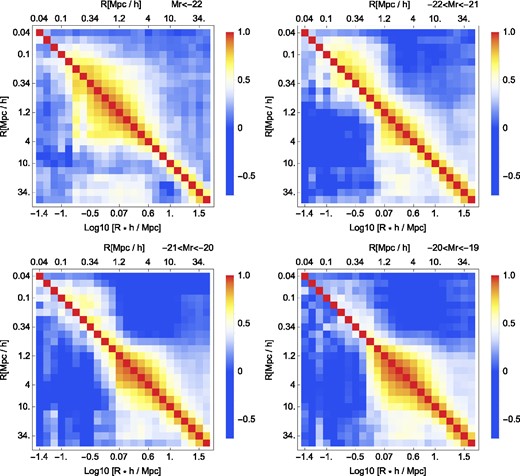

The jackknife cross-correlation matrix of wgg and ΔΣ, estimated from 64 samplings of one of the MXXL subcubes.
7 CONCLUSIONS
In this paper, we have explored the required ingredients for performing a joint likelihood analysis of GC and GGL. The combination of these probes has the potential to enable simultaneous constraints of the cosmological and galaxy formation model parameters.
In Section 2, we developed an analytic framework to predict the projected correlation function and the stacked tangential shears of a population of galaxies. We provided both exact and Limber-approximated expressions for the observables in the flat-sky limit. In Appendix A, we presented the full derivations of the auto- and cross-covariance matrices. In Section 3, we summarized the results for the case where the underlying density fluctuations are Gaussian and modulated by a shot-noise contribution. The two necessary ingredients for the results of Sections 2 and 3 are the galaxy–galaxy and galaxy–matter power spectra or alternatively a model for the bias defined by equations (39) and (40).
The theoretical predictions of the models were then tested against measurements from numerical simulations of structure formation. In Section 4, we provided a brief overview of the MXXL simulation. The galaxy catalogues were generated using the Garching SAM of galaxy formation, which enabled us to compute the u, g, r, i, z SDSS absolute magnitudes. As a diagnostic of the SAM galaxies we presented the evolution of the GLF for the five bands. We also explored certain properties of the galaxies as a function of absolute r-band magnitude (Mr), allowing us to understand the impact of the finite mass resolution of the MXXL simulation on the derived galaxy properties. Through detailed comparison with the Millennium simulation, we determined that resolution effects were qualitatively important only for magnitudes fainter than Mr > −19.
In Section 5, we described our methods for estimating the projected correlations from the MXXL. This required the implementation of fast and efficient algorithms, since the dark matter distribution was represented by over 300 billion dark matter particles and the galaxy catalogue contained more than a billion objects. We thus developed a parallel k-D tree algorithm for computing the correlation functions of the subsampled matter and galaxy distributions.
We split the galaxy catalogues into four subsamples based on their Mr, with the constraint that Mr < −19. We also sliced the dark matter and galaxy catalogues into a series of 216 subcubes of volume 500 h−3 Mpc3. As a step towards modelling the GC and GGL signals, we examined the projected galaxy–galaxy and galaxy-mass correlation functions using the estimator proposed by Landy & Szalay (1993). We also computed the bias coefficients as a function of scale from these statistics. We found that on large scales, R > 10 h−1 Mpc, the bias was consistent with being linear and deterministic. On smaller scales, the bias possessed a complex scale dependence, which varied with the magnitude bin through the larger number of satellites and their spatial distribution, as well as the decreasing host mass for the centrals in the fainter bins. We also found that the cross-correlation coefficient was significantly greater than unity on small scales. This could be explained as a consequence of an exclusion effect – no two galaxies may be closer than the sum of their respective virial radii.
We next computed the excess surface mass density ΔΣ, which is directly proportional to the tangential shear, and the projected galaxy correlation function for each of the magnitude bins and for each of the 216 subcubes. These were compared to the theoretical predictions in the Limber approximation. The evaluation of the theory required a model for the non-linear matter power spectrum and the scale dependence of the bias. For the former, we used the halofit code (Smith et al. 2003), and for the latter we took directly the measured bias. We found that on small scales the theory underpredicted the measurements by ≲20 per cent for wgg and by ≲30 per cent for ΔΣ. This was attributed to the diminished accuracy of halofit on small scales. Both functions displayed complicated features for galaxies in the faintest magnitude bin Mr > −20. This was again attributed to the increased abundance of satellite galaxies.
In Section 6, we used the measured estimates of wgg and ΔΣ from the subcubes to construct the auto- and cross-covariance matrices. We found that on large and small scales the errors were reasonably well described by the Gaussian plus shot-noise model. However, on intermediate scales, 0.1 < R < 10 h−1 Mpc, the measured errors were significantly larger by a factor of ∼2–3. This suggests that in order to accurately model the covariance matrix one needs to take account of the non-Gaussian contributions from the bi- and trispectrum. Note that in the case of GGL, the presence of shape noise does alleviate some of the non-Gaussianities on intermediate scales, as shown in Appendix C.
Finally, we compared the auto- and cross-covariances obtained from the jackknife samplings of one of the subcubes of MXXL with the full simulation covariances. We concluded that the jackknife method is remarkably effective, for both auto- and cross-covariances.
Importantly, we found that the cross-covariance between wgg and ΔΣ was not zero. The elements of the cross-covariance matrix showed significant bin-to-bin correlations with r ∼ 0.8 for some elements on large scales. This result is important, since in a number of previous analyses we neglected the cross-correlation of GC and GGL. Our results suggest that if these correlations are ignored, then a standard likelihood analysis would lead to biased and overoptimistic constraints on the parameters of the models.
In the future, more work will be required to establish an accurate model of the GC and GGL signals on scales R < 5 h−1 Mpc. We note that, whilst the SAM model of galaxy formation is not to be taken as an exact replica of reality, it nevertheless captures many of the effects that we expect to have to model when constraining model parameters with real data. It will also be important to determine how well the combination of GC and GGL can actually break the degeneracies between the galaxy formation and cosmological parameters. We shall aim to explore this in a future paper. In the meantime, we note that Eifler et al. (2014) have explored clustering and lensing probe combinations and have included additional non-Gaussian terms in the modelling of the covariances. However, they have assumed a rather simplistic modelling of the galaxy bias, which we showed here is not the case. This leads us to suspect that their results will be somewhat overoptimistic.
Another possibility is the exploration of the ϒ statistic (Baldauf et al. 2010; Mandelbaum et al. 2013), which was developed to remove the complicated scale dependences of the bias. However, what is not clear is whether the ϒ statistic in combination with GC can provide constraints on both the cosmological and galaxy formation model that are competitive with the standard statistics. We leave this for future work.
The authors would like thank Simon White, Eiichiro Komatsu, Peter Schneider and Gary Bernstein for useful discussions, Bruno Henriques for providing the Millennium simulation galaxy catalogue used in Fig. B1. They are also grateful to Volker Springel, Adrian Jenkins, Carlos Frenk and Carlton Baugh for their contribution to the MXXL simulation used in this study. The MXXL was carried out on Juropa at the Jülich Supercomputer Centre in Germany. LM thanks MPA for its kind hospitality while this work was being performed. LM was supported by the DFG through the grant MA 4967/1-2. RES acknowledges support from ERC Advanced Grant 246797 GALFORMOD.
Note that this result can also be obtained if in equation (23) one takes χmax → ∞.
REFERENCES
APPENDIX A: DERIVATION OF THE AUTO- AND CROSS-COVARIANCE MATRICES
A1 Derivation of the covariance matrix of stacked tangential shear
To simplify the notation, from now on we shall consider that all 2D integrals are implicitly done on the survey area Ωs without explicitly stating so in every case.
A2 Derivation of the covariance matrix of the 3D galaxy correlation function
A3 Cross-covariance matrix of stacked tangential shear and the projected galaxy correlation function
We shall compute the cross-covariance of the estimators for the angular correlation function of galaxies and the stacked tangential shear. We take this approach because the angular correlation function in a thin redshift shell – which is our assumption for the lens population throughout this study – is in fact equal to the projected correlation function.
APPENDIX B: GALAXY CATALOGUE COMPARISON
Fig. B1 presents various properties of galaxies from the Millennium simulation as a function of r-band magnitude, e.g. the fraction of each galaxy type, the host halo mass, the distance to the central galaxy and the subhalo mass. The galaxy catalogue is very similar to the MXXL one, used throughout this paper. The figure serves as a diagnostic for the impact of resolution effects on the distribution of galaxies, and by comparing it to Fig. 2 we selected only MXXL galaxies with Mr < −19 as a ‘reliable’ sample.
APPENDIX C: THE IMPACT OF SHAPE NOISE
We present a theoretical calculation of the impact of shape noise on the GGL results. Whilst we do not have shape noise in our simulations, we have particle shot noise, which qualitatively acts in a similar way to shape noise, but quantitatively is different.
The top panels of Fig. C1 illustrate the effect of shape noise on the GGL correlation matrix, for the brightest and faintest galaxy bins considered in this work. There are two consequences of increased shape noise or, equivalently, particle shot noise. First, the off-diagonal elements are present mostly on larger scales, e.g. ∼5 − 10 h−1 Mpc, compared to the lower MXXL noise, where they stretch to ∼1 h−1 Mpc. Secondly, the correlations are weaker. Since our predictions are obtained using the measured bias, there is also a dependence on magnitude, with the brighter galaxies being less correlated than the fainter ones. The bottom panels of the figure show the noise-to-signal, with the area of SDSS accounted for. As expected, the SDSS predictions are higher.
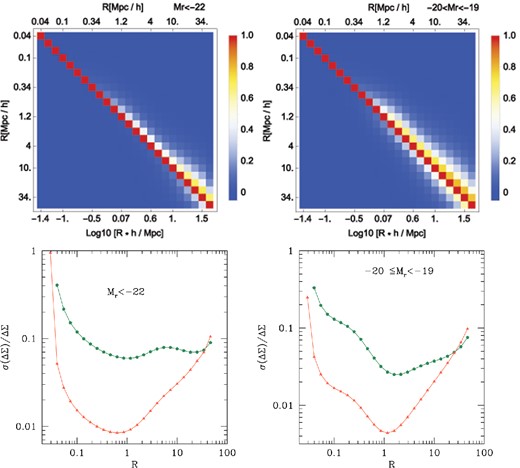
Theoretical estimates of the GGL correlation matrix and variance, illustrating the impact of shape noise for our brightest and faintest galaxy bins. Top panels: for each magnitude bin, the upper-right triangle corresponds to the level of noise from our MXXL measurements, while the bottom-left triangle has a shape noise similar to the SDSS measurements of Mandelbaum et al. (2013). Bottom panels: the noise-to-signal for the excess surface density. Green pentagons depict the prediction for the SDSS shape noise, and red triangles for the MXXL noise, i.e. the same as in Fig. 9.








